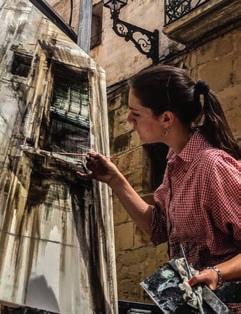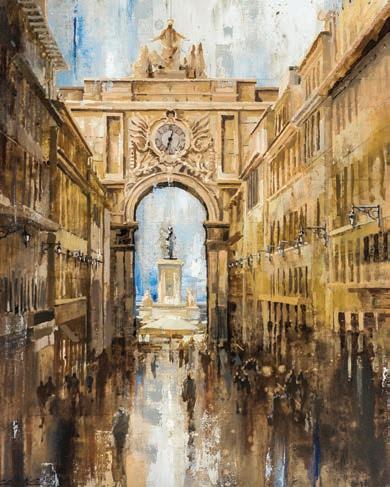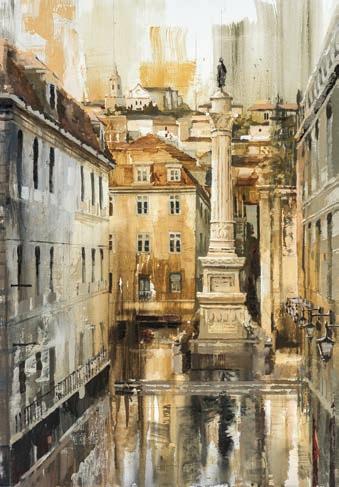
2 minute read
THE REDEVELOPMENT –
by Martin
rebirth in fact – of the capital, after the 1755 earthquake, an extensive system of town planning included neoclassical buildings lining wide streets laid out in grid formation. Each building was uniform in its design and built as an earthquake-proof structure. Never, in all of Europe, had anywhere so grand been seen before.
Aida Mauri is an artist and architect who can fully appreciate the exceptional quality of the city’s design and construction. Her paintings reflect the beauty of Lisbon’s architecture, earning her an unrivaled reputation. She uses a distinctive style that relies upon spontaneity and perspective.

Her portrayal of the Arco da Rua Augusta, built to commemorate the earthquake of 1755 and the city’s rebirth, is wonderfully triumphal. Working with almost abstract brushstrokes, her impression of the arch is powerful and handsome. Beyond it is the waterfront and the magnificent Terreiro do Paço – the Terrace of the Palace, including a huge equestrian statue of Dom João I.
When the first shops and apartments were completed and ready for occupation, few
What made you fall in love with Lisbon?
I love historical architecture and there is so much that makes Lisbon special..
The colour, the light, the grandiosity of the buildings, for me, they are poetry . I am very lucky to be able to paint these themes. I feel I am painting art.
Do you have a favourite building there?
There are so many that have people showed any enthusiasm for moving into the square. Preferring to live rent free in shanty towns that had grown up in the ruins around the city, their lives were soon to be disrupted. Soldiers arrived, destroyed their shacks and obliged them to move into the new buildings. a unique character, but It has to be the wonderful Rua Augusta Arch on Praça do Comércio.
In order to promote business, the Terreiro do Paço was renamed Praça do Comércio – Commerce Square. Today it is one of the most impressive squares in all of Europe. Remarkably one of the first restaurants to open in 1782 is still there – Martinho da Arcada.
Even older is the Casa do Alentejo, one of the few buildings to survive the earthquake. Aida’s painting portrays its palatial Moorish style and captures the atmosphere of a grand mansion built in the 1600’s for the Viscount of Alverca.
At the heart of Lisbon is the Praça of Dom Pedro IV. Painted from a unique angle, the dominating statue of the king is the focal point of Aida’s composition and the subject of an intriguing legend. Standing at a height of 23 metres (75 foot) it is impossible to study the statue in detail, but according to the story it was originally designed as a statue of Emperor Maximillian I of Mexico, who was shot before it was completed. After a few adjustments it was cast in bronze, sold at a reduced price and is said to be a representation of the Portuguese king. Perhaps this explains why locals dropped the square’s official title and continue to call it by its much older name Rossio, meaning common land.
Aida Mauri is a young Spanish artist from Catalonia who was first awarded a prize for her painting at 13. At age 15 she entered and won a competition for adults and subsequently went onto university, qualifying with an MA in Architecture. Her paintings have been celebrated in exhibitions all over Spain. Crossing the border into Portugal, this is her first opportunity to share her paintings with a new audience.
Have you been a regular visitor to Lisbon?
I would love to spend more time in the city than I can right now – my work schedule is packed.
Best time of day to paint?I
I love direct light, strong tones, the golden hour, and also the light on rainy days is a favourite of mine. I think these are all very romantic and can enhance the volumes of the buildings, making them magnificent.


Your preferred medium?
I have loved oils since I discovered them. However, in some of my work, I start with acrylics, and then finish very carefully with the oils, avoiding disrupting the colours.









